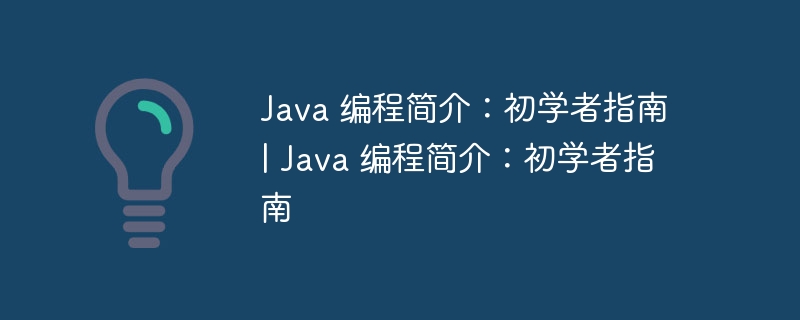Java 编程简介:初学者指南 | Java 编程简介:初学者指南
时间:2025-01-19 16:15:56 283浏览 收藏
本篇文章向大家介绍《Java 编程简介:初学者指南 | Java 编程简介:初学者指南》,主要包括,具有一定的参考价值,需要的朋友可以参考一下。

简介 | Introduction
意大利语: 本文提供意大利语和英语版本。向下滚动查看英语版本。
英语: 本文提供意大利语和英语版本。向下滚动查看英语版本。
意大利语版
Java 编程入门:初学者指南
简介
Java 是全球最流行、应用最广泛的编程语言之一。凭借其跨平台特性,它广泛应用于桌面、移动、Web 甚至物联网 (IoT) 应用开发。本指南将介绍 Java 基础知识、开发环境搭建以及编写第一个程序的方法。
1. 什么是 Java?
Java 是一种面向对象且跨平台的编程语言,这意味着用 Java 编写的程序可在任何支持 Java 虚拟机 (JVM) 的操作系统上运行。其设计目标包括:
- 简洁性:语法清晰易懂。
- 可移植性:一次编写,随处运行(“编写一次,随处运行”原则)。
- 安全性:包含高级安全管理功能。
- 高性能:JVM 优化使得 Java 能快速执行复杂操作。
2. 安装开发环境
开始 Java 编程前,需先搭建环境。
步骤 1:安装 JDK
Java 开发工具包 (JDK) 包含编写和运行 Java 程序所需的所有工具。您可从 Oracle 官网下载:
https://www.oracle.com/java/technologies/javase-downloads.html
步骤 2:配置 IDE
IDE(集成开发环境)能简化代码编写和调试过程。常用的 Java IDE 包括:
- IntelliJ IDEA(推荐给初学者)
- Eclipse
- NetBeans
步骤 3:配置环境变量
将 JDK 路径添加到 JAVA_HOME 环境变量,并更新 PATH 以便从终端运行 Java 命令。
3. 编写您的第一个 Java 程序
这是一个简单的 Java 程序示例,它会在控制台打印“Hello, world!”:
for (int i = 0; i < 10; i++) {
System.out.println(i);
}
**Conclusion**
Java is a versatile and powerful language well-suited for those starting their programming journey. After understanding the basics, you can explore more advanced topics such as object-oriented programming, frameworks, and much more.
**Translation | Traduzione**
This document was translated using a professional translation tool.
Questo documento è stato tradotto utilizzando uno strumento di traduzione professionale.
今天关于《Java 编程简介:初学者指南 | Java 编程简介:初学者指南》的内容就介绍到这里了,是不是学起来一目了然!想要了解更多关于的内容请关注golang学习网公众号!
-
501 收藏
-
501 收藏
-
501 收藏
-
501 收藏
-
501 收藏
-
325 收藏
-
126 收藏
-
235 收藏
-
478 收藏
-
338 收藏
-
332 收藏
-
450 收藏
-
313 收藏
-
229 收藏
-
127 收藏
-
135 收藏
-
471 收藏
-

- 前端进阶之JavaScript设计模式
- 设计模式是开发人员在软件开发过程中面临一般问题时的解决方案,代表了最佳的实践。本课程的主打内容包括JS常见设计模式以及具体应用场景,打造一站式知识长龙服务,适合有JS基础的同学学习。
- 立即学习 543次学习
-

- GO语言核心编程课程
- 本课程采用真实案例,全面具体可落地,从理论到实践,一步一步将GO核心编程技术、编程思想、底层实现融会贯通,使学习者贴近时代脉搏,做IT互联网时代的弄潮儿。
- 立即学习 516次学习
-

- 简单聊聊mysql8与网络通信
- 如有问题加微信:Le-studyg;在课程中,我们将首先介绍MySQL8的新特性,包括性能优化、安全增强、新数据类型等,帮助学生快速熟悉MySQL8的最新功能。接着,我们将深入解析MySQL的网络通信机制,包括协议、连接管理、数据传输等,让
- 立即学习 500次学习
-

- JavaScript正则表达式基础与实战
- 在任何一门编程语言中,正则表达式,都是一项重要的知识,它提供了高效的字符串匹配与捕获机制,可以极大的简化程序设计。
- 立即学习 487次学习
-

- 从零制作响应式网站—Grid布局
- 本系列教程将展示从零制作一个假想的网络科技公司官网,分为导航,轮播,关于我们,成功案例,服务流程,团队介绍,数据部分,公司动态,底部信息等内容区块。网站整体采用CSSGrid布局,支持响应式,有流畅过渡和展现动画。
- 立即学习 485次学习
